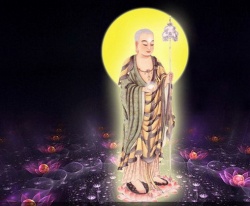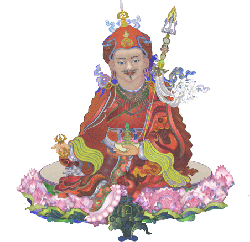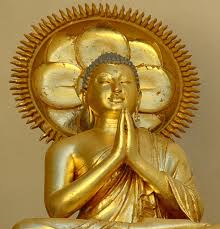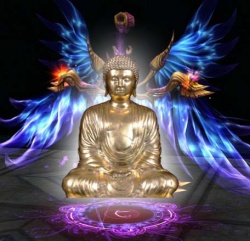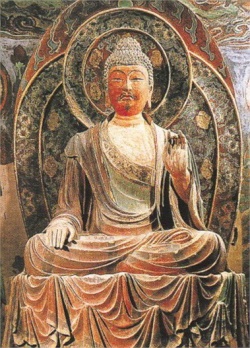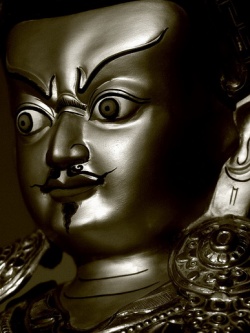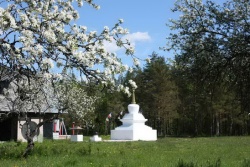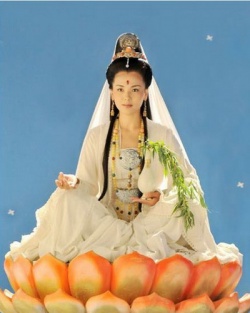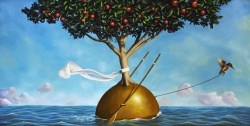Ryōbu Shintō
A general term referring to Shintō doctrines derived from Shingon esoteric Buddhism.
These doctrines associate the Inner Shrine of Ise with Dainichi of the Womb Realm (taizōkai) and the Outer Shrine with Dainichi of the Vajra realm (kongōkai);
in addition, these doctrines propose explanations, based on the teachings of esoteric Buddhism,
for the "original essences" (honji;
see honji suijakusetsu) of the deities, for the genesis of Japan, for the origin of the name "Japan," and for the foundations of the sovereign's authority.
The term Ryōbu Shintō derives from the teachings of Yoshida Kanetomo (1435-1511), the founder of Yoshida Shintō.
In his work Yuiitsu shintō myōbō yōshū]], Yoshida classified Shintō into three categories, one of which he called "combinatory Shintō based on the dual fundamental mandalas of Shingon esoteric Buddhism (ryōbu shūgō Shintō)."
Yoshida explained this form of Shintō in this way: "It identifies the Womb and the Vajra realms with the Inner and Outer Shrines of Ise, and the kami with the deities of the mandala.
Therefore I call it 'combinatory Shintō based on the two (mandalas).'"
Yoshida furthermore argued that Ryōbu shūgō Shintō is based on the teachings of the Buddhists Dengyō Daishi (Saichō),
Kōbō Daishi (Kūkai), Jikaku Daishi (Ennin) and Chishō Daishi (Enchin), and he thus seems to employ this term as a general appellation for Shintō doctrines developed by Buddhists (Bukka Shintō) of both Tendai and Shingon traditions.
Subsequently, however, the Tendai-derived Shintō came to be commonly known as Sannō Shintō, while Shingon-derived Shinto became known generally as Ryōbu Shintō, with the result that Ryōbu Shintō is also referred to as Shingon Shintō.
As we will see in more detail below, however, the influence of Tendai doctrines on the development of Ryōbu Shintō is stronger than that of Shingon, and there are even aspects of Ryōbu Shintō that cannot be reduced to Shingon; therefore, the standard definition is not without problems.
Ryōbu Shintō thought developed around the Ise Shrines between the end of the Heian period and the Nanbokuchō era; its formative process can be roughly divided into an earlier phase (late Heian to mid-Kamakura periods) and a later phase (late Kamakura to Nanbokuchō periods).
During the early phase, the Tenshō Daijin giki (also known as Hōshi wajōden) of the late Heian period is the first work to be composed (it dates to before 1164),
followed by the Mitsuno kashiwa denki and the Nakatomi no harae kunge (also known as Nakatomi no harae kige), both written in the early Kamakura period.
A common feature of these early works is their close relation to the Tendai Jimon school centered on the temple Onjōji: the Tenshō Taijin giki is attributed to the Onjōji priest Shōzen, whereas the other two texts are believed to have been written at the Sengūin (Yoshizu Mikuriya in Shima Province), a temple related to Onjōji.
By the mid- and late-Kamakura period, other texts were composed, such as the Kanchō harae kizai sangatsu mikka jōshi, the Sengūin himon, the Tenchi reikaku hisho, the Yamato Katsuragi Hōzan ki, and the Taisō hifu.
Of these, the Sengūin himon was attributed to Ennin and the Tenchi reikaku hisho to Saichō—other indications of a close connection with the Tendai tradition.
On the other hand, the Yamato Katsuragi Hōzan ki and the Taisō hifu were attributed to Gyōki,
who was also accredited with writing an early text of Ise Shintō, the Hōki hongi.
At the basis of these attributions was the fact that Gyōki was considered at the time as representing the connections between Ise Shrine and Buddhism,
as suggested by the legend of Gyōki's pilgrimage to Ise on the occasion of the construction of the temple Tōdaiji.
The increasing enthusiasm for the pilgrimage to Ise among the Buddhist priests responsible for the legend suggests a close relation with the formation of Ryōbu Shintō.
Moreover, these early Ryōbu Shintō texts played a decisive role in the formation of Ise Shintō.
In contrast with the aforementioned features of texts composed during the early phase of Ryōbu Shintō, works from the later phase show more elements from Tōmitsu (Shingon esoteric Buddhism).
This could be explained by an increased Shingon influence in the Ise area due to a growing passion among Shingon priests for the pilgrimage to Ise after the example set by Eison (he went to [[Ise] in 1273, 1275, and 1280), and the construction of the Hōrakusha (a religious facility built at Ise on the occasion of the Mongol invasions for the purpose of calling on Buddhist deities to defeat the enemy) in 1275 by Tsūkai, priest of the Sanbōin at Daigoji in Kyoto.
One of the features of Ryōbu Shintō texts of this latter phase is that many of them were attributed to Kōbō Daishi, something that, with the sole exception of the Nakatomi no harae kunge, had not occurred before.
Among the texts composed during the later phase of Ryōbu Shintō, we find the Reikiki, the Shinmei hiketsu, the Ryōgū gyōmon jinshaku, the Ryōgū honzei rishu makaen, the Zoku betsu himon, the Toyouke Kōtaijin keimon, and the Daijingū himon.
They were all attributed to Kūkai and it can be ascertained that they were all in existence by 1320.
They appear to have been composed under the influence of Ise Shintō (in a process that runs opposite to what happened in the early phase);
in any case, it is possible to infer that Ryōbu Shintō and Ise Shintō developed in a relationship of mutual influence.
Another characteristic of later Ryōbu Shintō is that it was increasingly transmitted outside of Ise at Shingon temples of the Ono and Hirosawa branches.
In this process, particularly important were Miwa-ryū Shintō and Goryū Shintō.
Miwa-ryū Shintō was transmitted especially at the temples Ōmiwadera (Ōgorinji) and Byōdōji on Mount Miwa.
Kyōen (or Keien) (1140-1223), the founder of the Byōdōji, and his disciples may have already had been developing teachings concerning the kami in the Miwa area,
but it was with the construction of the Ōmiwadera by Eison (1201-1290) in 1285 that Ryōbu Shintō was brought to Miwa and began to develop as a separate tradition.
The first text of Miwa-ryū Shintō is the Miwa Daimyōjin engi (1317);
it explains that Amaterasu in Takamanohara, the deities enshrined at Ise, and Miwa Daimyōjin are three different forms of the cosmic Buddha Dainichi Nyorai.
Goryū Shintō (also known as Daishi-ryū Shintō) seems to have taken shape around the early fourteenth century led by Enkai, a priest of the temple Murōji, which was located near Ise.
Enkai is said to have restored the temple Seigiji in Ise Yamada.
He also studied under Ninkū, one of Eison's disciples.
Considering the proximity of Murōji to Ise, it is easy to understand that Ise's Ryōbu Shintō (and Ise Shintō) was brought to Murōji and further developed there.
The transmission of these various traditions of Ryōbu Shintō was carried out through ceremonies called jingi kanjō ("kami unction"),
rites based on the initiation ritual of esoteric Buddhism known as denbō kanjō ("Dharma-transmission unction").
There are many variants of transmission ceremonies, such as Ise kanjō, Nihongi kanjō, and Reiki kanjō.
These rituals were performed in many places throughout the middle ages.
Ryōbu Shintō ideas were included in many artistic texts such as commentaries on the Kokin waka shū and Noh performances, and thus spread among a wider audience well beyond the clergy.
Ryōbu Shintō also flourished during the Edo period, when it was transmitted at temples all over the country.
The major texts of the tradition, starting with the Reikiki, and other works containing doctrinal instructions and ritual procedures, such as the Ryōbu Shintō kuketsu shō by Minamoto Keian, were printed during the Edo period;
however, there was also an increasing wave of criticism by Confucianists and Nativists against Ryōbu Shintō, and even some Buddhists began to reject its teachings.
Some new developments also occurred, such as the creation of Unden Shintō (also known as Katsuragi Shintō) by Jiun Sonja Onkō (1718-1804), but the edicts ordering the separation of Shintō and Buddhism (Shinbutsu bunri rei),
issued by the Meiji government in 1868 resulted in the complete rejection of Ryōbu Shintō, which thus disappeared from the surface of history. See also Bukka Shintō
—Itō Satoshi
